When King García I chose Ribadavia as the capital of the Kingdom of Galicia (1063-1065), the first Jews must have arrived in Ribadavia though we can say that the Jewish quarter formed around the 12th and 13th centuries, encouraged to do so both by the settlement of Jews since the 10th century in the neighbouring area of Celanova as by the presence of a powerful group of merchants in Ribadavia since the granting of the Royal Charter by Fernando II in 1164.
Surrounded by green mountains and valleys in the midst of a prime natural environment at the confluence of the waters of the Avia and the Miño, the Historic-Artistic site of Ribadavia, recognised as such in 1947, contains a Jewish quarter endowed with great medieval resonance, bearing testimony to the existence of a community where the Jewish rites survived long after the expulsion of 1492, giving rise to one of the most famous inquisitorial proceedings of the 17th century. Along with the constant evocation of its Jewish past by portraying the malsín or the recreation of the Jewish wedding, the route through the Jewish district of Ribadavia allows you to visit streets packed with atmosphere and history, adorned by the presence of Romanesque palaces and churches and a must stop at the ovens and bakeries where the sweets are made according to the old Sephardi recipes.
circa 1064
The first Jews arrive in Ribadavia
circa 1164 - 1492
The Jewish district
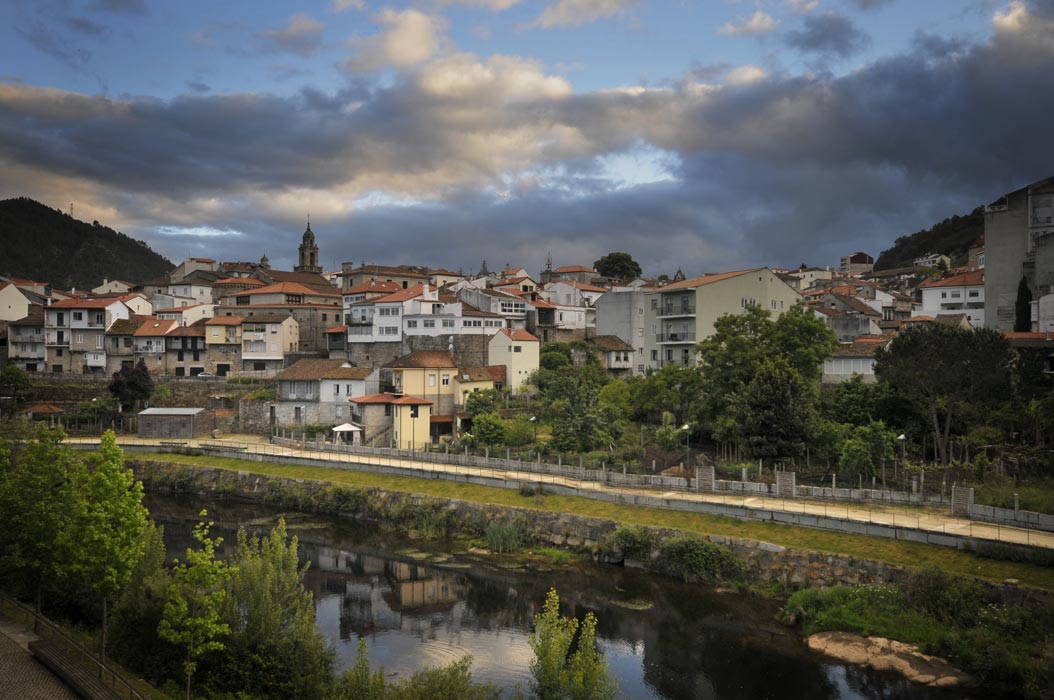
The Jewish district of Ribadavia still retains the medieval layout of its long, narrow roads, corners of streets and squares, porticoed by cantilevers and courtyards surrounded by façades where time seems to have stood still.
When King García I chose Ribadavia as the capital of the Kingdom of Galicia (1063-1065), the first Jews must have arrived in Ribadavia though we can say that the Jewish quarter formed around the 12th and 13th centuries, encouraged to do so both by the settlement of Jews since the 10th century in the neighbouring area of Celanova as by the presence of a powerful group of merchants in Ribadavia since the granting of the Royal Charter by Fernando II in 1164. Many Jews took charge of the management of the financial matters of the Manor and subsequently of the Count of Ribadavia, specializing in the administration of properties and rents and in various craft trades. They were also prominent as wine merchants.
The Jewish quarter extended between the main square and the medieval wall. Its centre was situated around Xudería (Jewish quarter) street which joins the main square to Madalena square. An ever present element in this Jewish quarter, continuing through the streets and the colonnades, is stone. The Jewish markets were located on the ground floors of the houses, thereby avoiding the sun from shining in for the convenience of customers and to preserve the foods. The balconies jut out prominently into the street to protect the ground floors from the rain; furthermore, flagstones were placed in front of their own doors to serve as platforms, raised a few centimetres above the street level so the ground humidity does not penetrate their premises.
1476
Kennicott Bible
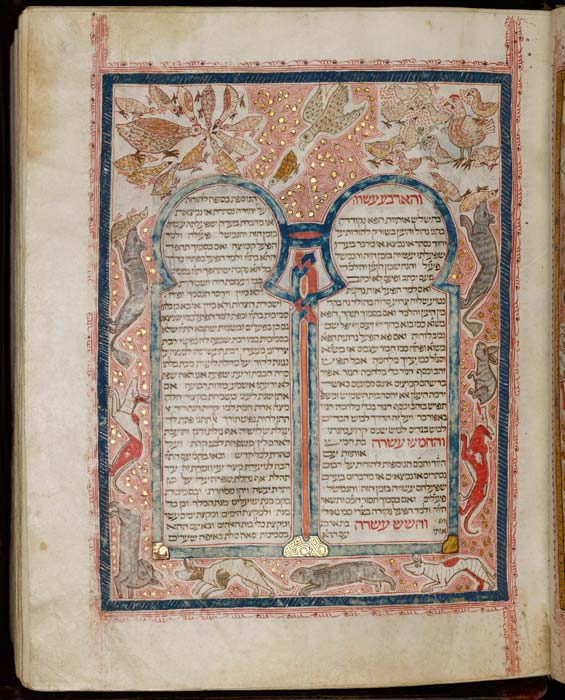
In one of its rooms the Jewish Information Centre of Galicia has set up a digital system for consulting, page by page, the famous Kennicoty Bible, the most important Religious Jewish manuscript throughout the Middle Ages in Galicia and whose original is kept in Oxford.
Dated in La Coruña in 1476, it comprises 922 pages written in the beautiful Hebrew of Moses ibn Zabarah, 238 of them exquisitely illustrated by Josef ibn Hayyim and in 1771 it was acquired in England by Benjamin Kennicott, who lent it his name.
circa 1510
House of the Inquisition
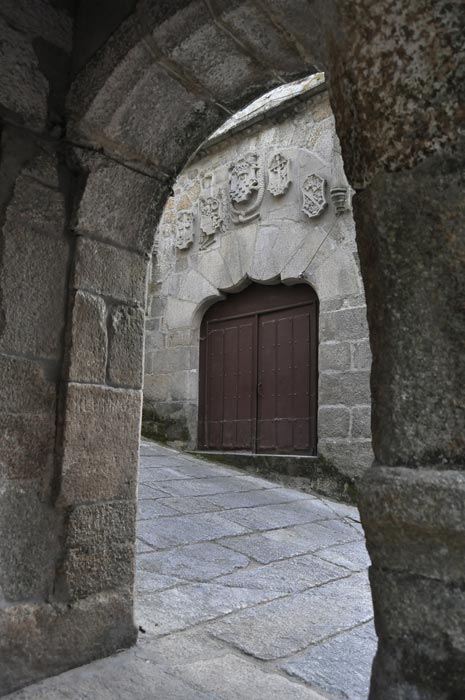
At the corner of Jerusalén street with San Martiño street there lies the house of the Inquisition, a fortified, 16th century palace with a beautiful Renaissance courtyard inside which, on its façade, over the door, boasts the coats-of-arms of the families of the Holy Office who settled here such as the Puga, the García Gamba, the Baamonde and the Mosquera-Sandoval, as well as the actual coat-of-arms of the Inquisition with its cross converted into a sword.
The case of the Crypto-Jews of Ribadavia serves as one of the best illustrations of the resistance of many Spanish Jews to the expulsion of 1492, giving rise to the phenomenon of the converts which shook Spanish society in the 16th and 17th centuries.
1545
Town Hall
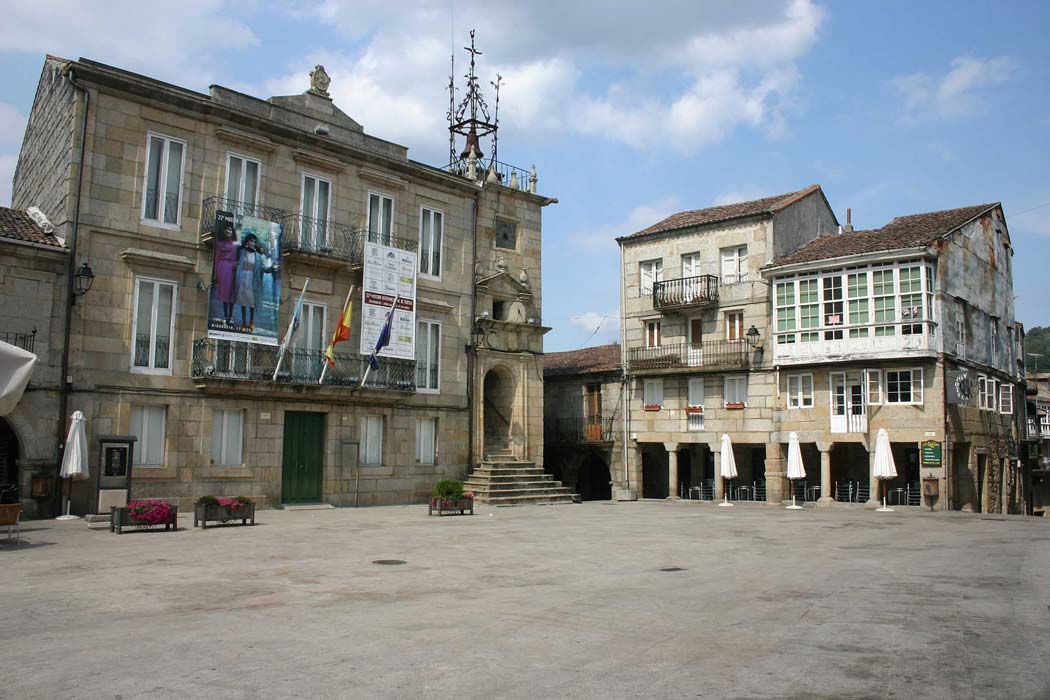
Opposite the Counts´ palace there lies the Town hall, built between 1545-1555 as a corn exchange and place for Town council meetings. The tower ousts a beautiful wrought iron belltower, in addition to its sun dial from the 18th century, its wind-up clock from the 19th century and the representation of the old coat-of-arms of the town which recalls that the fame of Ribadavia preceded it all around the world thanks to the commercialisation of its wines throughout Europe and the new world between the 10th and 18th centuries.
In the 19th century the façade was renovated and the colonnades were covered, conserving today, of the old building, the tower formed by 3 overlaid bodies endowed with the old coats-of-arms of the town and the wind-up clock from 1902. Also worthy of note is the artistic, wrought iron belltower.
It was at the town hall that the wine-producing ordinances of Ribadavia were drawn up in the 16th century, the precursor in Spain to the current wine-growing designation of origin and recognized by the WIPO as the oldest wine-producing Designation of origin in Spain.
1606
'The Malsín' Case
the case which made Ribadavia famous as regards its Judaizing converts was the famous proceedings of The malshin, the name traditionally given to the New Christian Xerónimo Bautista de Mena who, in 1606, submitted to the Holy Office a list with two hundred people accused of continuing to follow the Law of Moses despite having been baptized as Christians, starting with his own mother, Ana Méndez, and his brothers, sisters and in-laws. Those denounced included chief magistrates, alguaciles, students, doctors, lawyers and traders.
1607
Those accused of El Malsín are arrested
The majority of the arrests occurred in 1607 as many of those denounced escaped in 1606 and in that same year Xerónimo Bautista de Mena, the accuser, was found murdered in a street in Ribadavia and the perpetrators were never found.
1608
'Auto de fe' held in Santiago to try the defendants from Ribadavia
In 1608 a large auto de fe was held in Santiago with 28 accused parties from Ribadavia and Felipe Álvarez and his son Antonio Méndez were burned at the stake.
1609
Another 'auto de fe' to try seven defendants from Ribadavia
in 1609 a new auto was held with seven further defendants from the town. Nevertheless, the investigations of the Holy Office finally lead to the suspicions falling on the accuser himself and his body was dug up and his bones burned for heresy in 1610.
1693 - 1868
The Festa da Historia (History Festival)
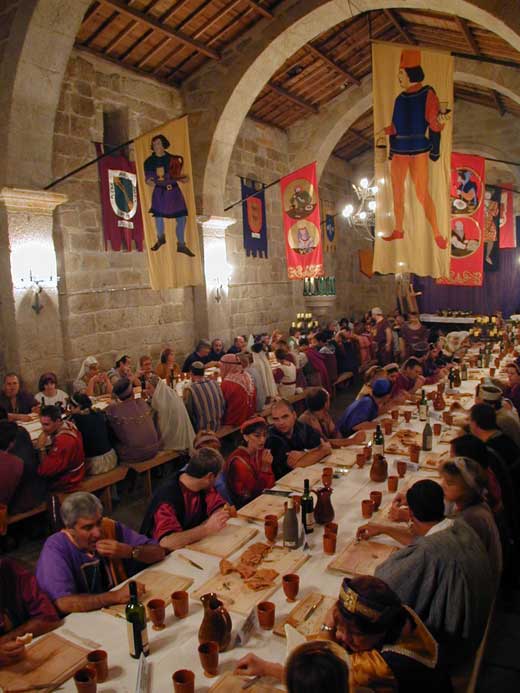
The Festa da Istoria, declared as being in the National Tourist Interest, is held during the last weekend in August and open to the public following a tradition which goes back to 1693, solely interrupted between 1868 and 1989.
The portrayal of the Jewish wedding, along with a performance of the play El malsín (The Slanderer), inspired by the persecution of the Judaizers, is one of its main offerings. The town becomes genuinely medieval: Locals and visitors wear costumes from the time to take part in games, cooking contests and activities tested in the previous months: the medieval ball, jousting, the Jewish wedding, human chess and much more. It is a celebration which is so rooted in the town that for two or three months beforehand many of the residents take part in making costumes from the age, standards, shields and accessories.
After changing Euros for maravedis at the corn Exchange bank, hundreds of residents and visitors dressed up in medieval attire, enter the time tunnel and go back to the Middle Ages when the Jews played a major role in the town.
1990
La Tafona da Herminia opens
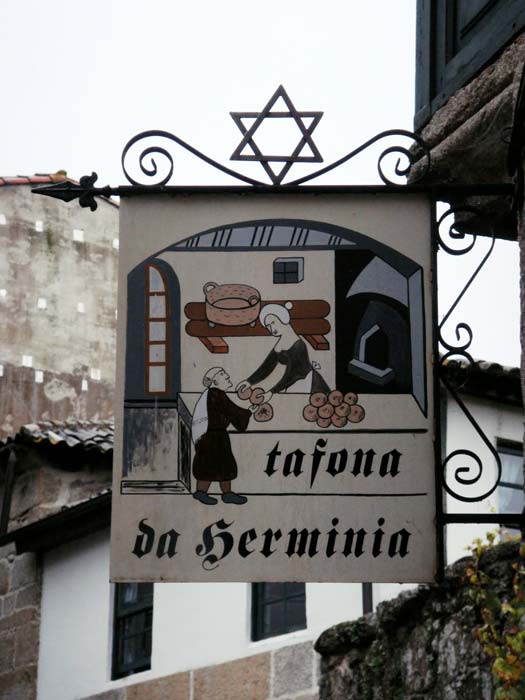
At Herminia´s Bakery, Herminia bakes typical Jewish pastas according to traditional recipes: Bocadiños de améndoas (made from almond and cinnamon), kamisch-broit (made from walnuts or almonds), mamul (with dried fruits, poppy petals and orange blossom water), ma'amul (dates cream and rose water), ghorayebah (whole hazelnut flour), mostachudos (walnuts and clove), bocadiños de dates (dates and nuts), kupferlin (almond wholemeal flour), kijelej de mon (poppy seeds), masiñas de poppies (poppy sedes and vanilla flavouring) and cardamom (almonds and cardamom) are her main specialities, along with tasty doughnuts in the form of the Star of David and other details.
Some of the ingredients are imported directly from Israel. Herminia explains that visitors to her bakery from all over Europe recognise that today it is the only establishment where they have been able to find certain biscuit specialities made according to the typical Jewish recipe.
Herminia started making them a few years ago on the occasion of the Festa da Historia and the locals and visitors liked them so much that she decided to keep making them until today.
Glossary
- :
- governor: High dignitary who managed or too forward a military and civil legal venture by mandate, behest and under royal command.
- jewish quarter: Traditional name given to the Jewish district or part of a city where the Jews´ homes were concentrated. In some cases it was determined by law as an exclusive place of residence of the members of this community. By extension, the term applies to any area known to be inhabited by families of Jewish culture.
- kosher, l. heb: This means ‘suitable´ and it designates the set of dietary laws and standards on foodstuffs deemed to be pure and which could be eaten according to Jewish law.
- mikveh, l. heb: Ritual bathing. Space where the purification baths prescribed by Judaism are taken.
- rabbi, l. heb: A man instructed and ordained in the law who can spiritually lead a community. It literally means ‘master´.
- sephardi, l. heb: Jew of Hispanic origin.
- torah, l. heb: Text of the first five books of the Bible.
- aljama, l. heb: Specific institution of the Medieval Hispanic kingdoms which dealt with the governance and internal administration of the Jewish community.
- collection: self-governing Jewish organisation which brought together several aljamas for economic reasons the distribution, valuation and collection of taxes to be submitted to the king.
- converts converts: A christened Jew who has converted to Christianity.Jews converted to Christianity who returned to their place of origin after expulsion.
- corn exchange: Place where grain was stored and traded.
- jupa, l. heb: Wedding canopy.
- ketubah, l. heb: Marriage contract.
- maravedis: Tax in force between the 13th and 18th centuries in the kingdoms of Valencia and Majorca by James I under the statute of April 14th 1266 and it consisted of payment of seven royal sueldos of Valencia (one maravedi) every seven years for each dwelling which had property valued at fifteen maravedis or more.
- menorah, l. heb: Candelabra or oil lamp with seven branches, one of the ritualistic elements of Judaism and also one of its oldest symbols; it is meat to represent the burning bushes seen by Moses on Mount Sinai (Exodus, 25).
- synagogue, l. gr: Gathering place for faithful Jews and the place of worship and studies. The term comes from the Greek synagogē which means place of congregation.

